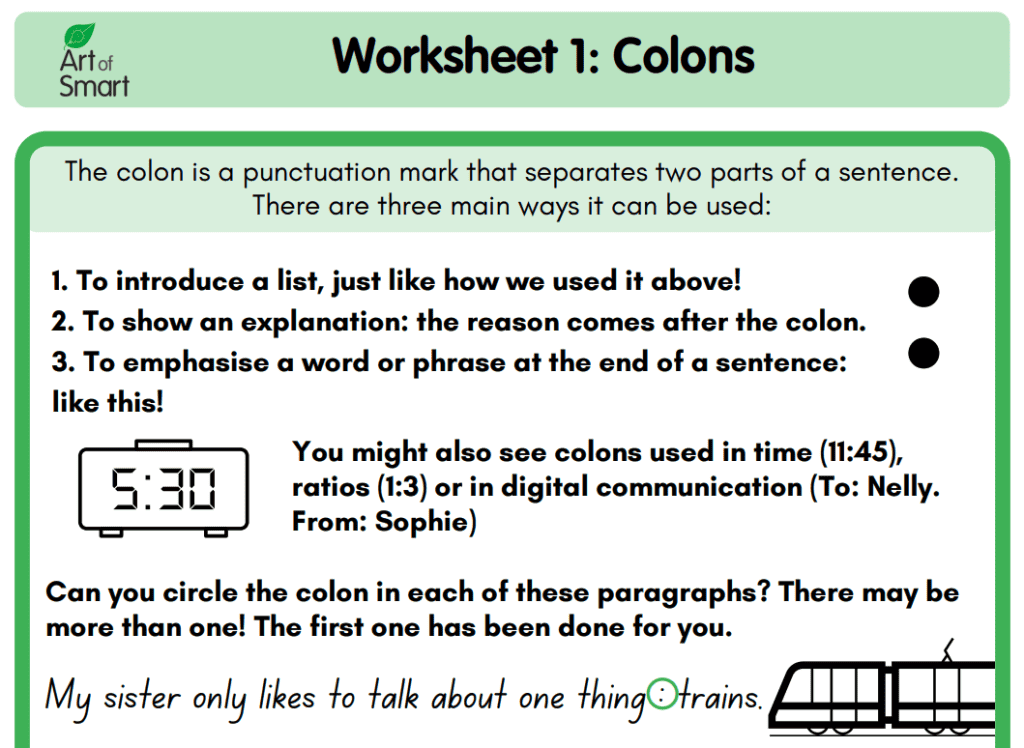On the hunt for punctuation worksheets for Year 5 students? You’ve come to the right place!
We’ve crafted a range of Year 5 punctuation worksheets covering colons, semicolons, parentheses and dialogue, which you can download for FREE.
What are you waiting for? Let’s get started!
Year 5 Punctuation Worksheets Sample
English Skills for Year 5 Students
Download Our Year 5 Punctuation Worksheets
Searching for punctuation worksheets for different year groups?
If you have a child in another year group, don’t worry! We’ve created worksheets for them that you can also download for FREE:
Kindergarten | Year 1 | Year 2 | Year 3 | Year 4 | Year 6
Year 5 Punctuation Worksheets Sample
Not sure what to expect when downloading our worksheets? You can check out a preview below:
To access the full set of FREE Year 5 Punctuation worksheets and activities on colons, semicolons, parentheses and dialogue, enter your email below!
English Skills for Year 5 Students
With your child in Year 5, the main punctuation concepts they will be learning about are colons, semicolons, parentheses and dialogue.
In addition to developing their punctuation skills, they will improve their vocabulary and reading ability.
Vocabulary
Now that your child is entering Stage 3 (Years 5 and 6) of their learning journey, they will be exposed to more complex forms of communication.
They may encounter more foreign language, but with consistent use of these words will build familiarity and their vocabulary.
Spelling lists are a great way of learning new words and finding ways to use them in everyday interactions.
Access our FREE spelling worksheets for Year 5 students!
Reading
You’ll find that the further into primary school your child goes, the less they’ll rely on you for guidance, especially with reading.
While they may not be asking for your help, you can still be involved with their literacy by sourcing texts that are recommended for their year group.
Find the best books for Year 5 students!
Punctuation Use Through Colons, Semicolons, Parentheses and Dialogue
In Year 5, your child will already know about how to use colons and semicolons from their English lessons in the year before. However, they may not know about the uses of parentheses and dialogue!
Parentheses are used to add extra information into a sentence. This extra information might clarify what a word or phrase in the text is referring to.
When writing down what people have said, it is called a quote or dialogue. Speech marks are written around it to show it has been said.
For more on these punctuation concepts, you can check out our Year 5 Punctuation worksheets below!
Download Our Year 5 Punctuation Worksheets
Ready to download our Year 5 punctuation worksheets? Enter your email below:
Discover everything you need to know about your child studying Year 5 English!
On the hunt for spelling worksheets for different year groups?
If you have children in other year groups, we’ve got you covered! We’ve got worksheets dedicated to the different primary school year groups as well as Year 7:
Kindergarten | Year 1 | Year 2 | Year 3 | Year 4 | Year 6 | Year 7
Looking for some extra help for your child with English?
We have an incredible team of English tutors and mentors!
We offer tutoring and mentoring for students in Years K-12 in a variety of subjects, with personalised lessons conducted one-on-one in your home or at our state of the art campus in Hornsby or the Hills! Find personalised tutoring in Sydney suburbs including K-6 tutoring in Penrith, and Holistic tutoring in Hurstville!
We’ve supported over 8,000 students over the last 11 years, and on average our students score mark improvements of over 20%!
We offer English tutoring for P-6 in the Brisbane area! Get paired with your expert tutor today!
To find out more and get started with an inspirational English tutor and mentor, get in touch today or give us a ring on 1300 267 888!
Jessica Loch is a K-6 English Resource Designer at Art of Smart in her second year at the University of Sydney studying Primary Education. She is passionate about learning and helping young students to grow and improve.




